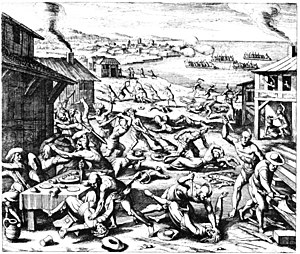Ralph Hamor
Funded by the earls of Salisbury, Suffolk, Southampton, Pembroke, and others, a third fleet of nine ships set sail in May, 1609, with 500 people aboard for what would be known as Jamestown.
But, as the fleet passed Bermuda on July 25, the tail end of a hurricane caught the flagship, which carried 150 passengers, stranding it on the island and sinking one of the other smaller vessels.
On April 9, 1610, Hamor escorted Lord Delaware and about 100 new settlers, including "Frenchmen to plant vines, and Swiss to find mines" aboard De La Warr, Blessing of Plymouth and Hercules of Rye, back to Virginia.
[7] In 1611, Hamor and Thomas Savage visited the Native American village of Matchcot, to sit with Powhatan, father of Pocahontas.
Hamor forgot to wear the pearl necklace to signify his status as a representative of his government, but told the chief that Sir Thomas Dale wanted to marry one of his daughters.
Hamor wrote in a letter to the council after the attack on the Flowerieu Hundred plantation: "So sudden in their cruel execution, that few or none discerned the weapon or blow that brought them to destruction.
On June 27, Hamor reached an agreement with the King of the Potomac Indians against the Opechancanough and Necochincos tribes, "Their and our enemy."
As a council member, Hamor was granted land from the Virginia Company in June 1621, upon which he began to establish his own plantation.
[10] One of Hamor's official duties as council member was to insure that Lady Cecily Delaware was satisfied with the cultivation of her assigned Virginian land.
Once things settled down, Hamor found himself in a land dispute with one of the biggest plantation owners in Virginia, Edward Bennett.
[10] By 1625, Hamor had acquired 250 acres on Hog Island, and another 500 acres at Blue Point, while remaining involved in legal matters of the Jamestown colony, including land disputes, public blasphemy hearings, illegal alcohol sales, even the authorization of the arrest of the town's gunsmith John Jefferson, who eloped with his maidservant.

